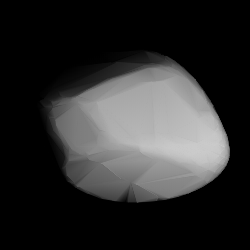Astronomy:1187 Afra
 Modelled shape of Afra from its lightcurve | |
| Discovery[1] | |
|---|---|
| Discovered by | K. Reinmuth |
| Discovery site | Heidelberg Obs. |
| Discovery date | 6 December 1929 |
| Designations | |
| (1187) Afra | |
| Named after | unknown[2] |
| 1929 XC | |
| Minor planet category | |
| Orbital characteristics[3] | |
| Epoch 31 May 2020 (JD 2459000.5) | |
| Uncertainty parameter 0 | |
| Observation arc | 90.16 yr (32,932 d) |
| |{{{apsis}}}|helion}} | 3.2285 AU |
| |{{{apsis}}}|helion}} | 2.0523 AU |
| 2.6404 AU | |
| Eccentricity | 0.2227 |
| Orbital period | 4.29 yr (1,567 d) |
| Mean anomaly | 52.040° |
| Mean motion | 0° 13m 46.92s / day |
| Inclination | 10.697° |
| Longitude of ascending node | 327.16° |
| 74.956° | |
| Physical characteristics | |
| Mean diameter | |
| Rotation period | |
| Geometric albedo | |
| SMASS = X[3] | |
| Absolute magnitude (H) | 11.50[1][3] |
1187 Afra (prov. designation: 1929 XC) is a dark background asteroid from the central regions of the asteroid belt. It was discovered by German astronomer Karl Reinmuth at Heidelberg Observatory on 6 December 1929.[1] The X-type asteroid has a rotation period of 14.1 hours and measures approximately 32 kilometers (20 miles) in diameter. The origin of the asteroid's name remains unknown.
Orbit and classification
Afra is a non-family asteroid of the main belt's background population when applying the hierarchical clustering method to its proper orbital elements.[4][5] It orbits the Sun in the central asteroid belt at a distance of 2.1–3.2 AU once every 4 years and 3 months (1,567 days; semi-major axis of 2.64 AU). Its orbit has an eccentricity of 0.22 and an inclination of 11° with respect to the ecliptic.[3] The body's observation arc begins at Heidelberg in January 1930, seven weeks after its official discovery observation.[1]
Naming
It is not known to what person, group of persons, or occurrence the name "Afra" refers to.[2]
Unknown meaning
Among the many thousands of named minor planets, Afra is one of 120 asteroids, for which no official naming citation has been published. All of these low-numbered asteroids have numbers between 164 Eva and 1514 Ricouxa and were discovered between 1876 and the 1930s, predominantly by astronomers Auguste Charlois, Johann Palisa, Max Wolf and Karl Reinmuth.[13]
Physical characteristics
The lightcurve of Afra shows a periodicity of 14.09±0.02 hours, during which time the brightness of the object varies by 0.40±0.02 in magnitude.[11][14]
References
- ↑ 1.0 1.1 1.2 1.3 1.4 Cite error: Invalid
<ref>tag; no text was provided for refs namedMPC-object - ↑ 2.0 2.1 Schmadel, Lutz D. (2007). "(1187) Afra". Dictionary of Minor Planet Names. Springer Berlin Heidelberg. p. 100. doi:10.1007/978-3-540-29925-7_1188. ISBN 978-3-540-00238-3. https://archive.org/details/dictionaryminorp00schm.
- ↑ 3.0 3.1 3.2 3.3 3.4 "JPL Small-Body Database Browser: 1187 Afra (1929 XC)". Jet Propulsion Laboratory. https://ssd.jpl.nasa.gov/sbdb.cgi?sstr=2001187. Retrieved 14 March 2020.
- ↑ 4.0 4.1 "Asteroid 1187 Afra – Proper Elements". AstDyS-2, Asteroids – Dynamic Site. https://newton.spacedys.com/astdys/index.php?pc=1.1.6&n=1187.
- ↑ 5.0 5.1 "Asteroid 1187 Afra". Small Bodies Data Ferret. https://sbntools.psi.edu/ferret/SimpleSearch/results.action?targetName=1187+Afra. Retrieved 14 March 2020.
- ↑ 6.0 6.1 Tedesco, E. F.; Noah, P. V.; Noah, M.; Price, S. D. (October 2004). "IRAS Minor Planet Survey V6.0". NASA Planetary Data System 12: IRAS-A-FPA-3-RDR-IMPS-V6.0. Bibcode: 2004PDSS...12.....T. https://sbnarchive.psi.edu/pds3/iras/IRAS_A_FPA_3_RDR_IMPS_V6_0/data/diamalb.tab. Retrieved 14 March 2020.
- ↑ 7.0 7.1 Usui, Fumihiko; Kuroda, Daisuke; Müller, Thomas G.; Hasegawa, Sunao; Ishiguro, Masateru; Ootsubo, Takafumi et al. (October 2011). "Asteroid Catalog Using Akari: AKARI/IRC Mid-Infrared Asteroid Survey". Publications of the Astronomical Society of Japan 63 (5): 1117–1138. doi:10.1093/pasj/63.5.1117. Bibcode: 2011PASJ...63.1117U. (online, AcuA catalog p. 153)
- ↑ 8.0 8.1 Mainzer, A. K.; Bauer, J. M.; Cutri, R. M.; Grav, T.; Kramer, E. A.; Masiero, J. R. et al. (June 2016). "NEOWISE Diameters and Albedos V1.0". NASA Planetary Data System. Bibcode: 2016PDSS..247.....M. https://sbnarchive.psi.edu/pds3/non_mission/EAR_A_COMPIL_5_NEOWISEDIAM_V1_0/data/neowise_mainbelt.tab. Retrieved 14 March 2020.
- ↑ Ďurech, J.; Hanuš, J.; Oszkiewicz, D.; Vančo, R. (March 2016). "Asteroid models from the Lowell photometric database". Astronomy and Astrophysics 587: A48. doi:10.1051/0004-6361/201527573. ISSN 0004-6361. Bibcode: 2016A&A...587A..48D.
- ↑ Behrend, Raoul. "Asteroids and comets rotation curves – (1187) Afra". Geneva Observatory. http://obswww.unige.ch/~behrend/page3cou.html#001187. Retrieved 14 March 2020.
- ↑ 11.0 11.1 Menke, John; Cooney, Walt; Gross, John; Terrell, Dirk; Higgins, David (October 2008). "Asteroid Lightcurve Analysis at Menke Observatory". Minor Planet Bulletin 35 (4): 155–160. ISSN 1052-8091. Bibcode: 2008MPBu...35..155M. http://www.minorplanet.info/MPB/issues/MPB_35-4.pdf.
- ↑ Clark, Maurice (July 2019). "Asteroid Photometry from the Preston Gott Observatory". Minor Planet Bulletin 46 (3): 346–349. ISSN 1052-8091. Bibcode: 2019MPBu...46..346C. http://www.minorplanet.info/MPB/issues/MPB_46-3.pdf.
- ↑ Cite error: Invalid
<ref>tag; no text was provided for refs namedDOMPN-unknown - ↑ "LCDB Data for (1187) Afra". Asteroid Lightcurve Database (LCDB). http://www.minorplanet.info/PHP/generateOneAsteroidInfo.php?AstInfo=1187. Retrieved 14 March 2020.
External links
- Lightcurve Database Query (LCDB), at www.minorplanet.info
- Dictionary of Minor Planet Names, Google books
- Asteroids and comets rotation curves, CdR – Geneva Observatory, Raoul Behrend
- Discovery Circumstances: Numbered Minor Planets (1)-(5000) – Minor Planet Center
- 1187 Afra at AstDyS-2, Asteroids—Dynamic Site
- 1187 Afra at the JPL Small-Body Database
 |

